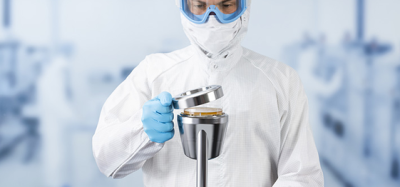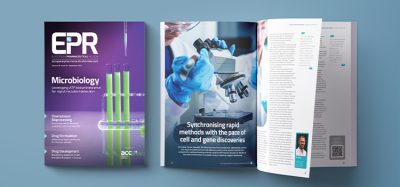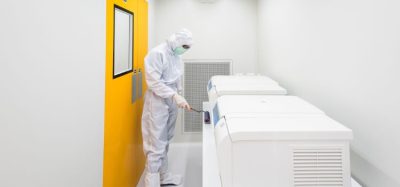Co-operation through certification
Posted: 24 March 2006 | | No comments yet
To verify that cleanroom and clean zones are adequately installed and functioning they are usually validated during three occupancy states. First, when the installation is complete with all services connected and functioning, as-built; secondly during at-rest conditions when equipment is installed and running in a manner agreed upon by customer and supplier; and finally during operational conditions with the specified number of personnel present and working in a manner agreed upon. This is described in the standard documents of ISO/EN 14644 Cleanrooms and associated controlled environment.
To verify that cleanroom and clean zones are adequately installed and functioning they are usually validated during three occupancy states. First, when the installation is complete with all services connected and functioning, as-built; secondly during at-rest conditions when equipment is installed and running in a manner agreed upon by customer and supplier; and finally during operational conditions with the specified number of personnel present and working in a manner agreed upon. This is described in the standard documents of ISO/EN 14644 Cleanrooms and associated controlled environment.
To verify that cleanroom and clean zones are adequately installed and functioning they are usually validated during three occupancy states. First, when the installation is complete with all services connected and functioning, as-built; secondly during at-rest conditions when equipment is installed and running in a manner agreed upon by customer and supplier; and finally during operational conditions with the specified number of personnel present and working in a manner agreed upon. This is described in the standard documents of ISO/EN 14644 Cleanrooms and associated controlled environment.
The test that determines the quality of air to the cleanroom and clean zone is the installed filter leakage test. For the customer it is of utmost importance that this test is performed correctly and reported in a manner agreed upon. The standards 14644-3 (2006) requires that all instruments used should be calibrated and that calibration data should be reported. When the filters are challenged with particles, the challenge level before the filter should be measured and documented before and after the leakage test. Should one discover any leakage in the media or from the gasket it should be correctly reported.
Not all cleanrooms are built or maintained by cleanroom or contamination control specialists. Even in pharmaceutical and biotech research and manufacturing areas, cleanrooms can be maintained by a maintenance company that might not have seen a cleanroom until the day they first walk through the door.
Lately, concerns about the knowledge of cleanroom validations with cleanroom testing have been expressed by the Norwegian Medicinal Control authorities, among others. Sometimes the knowledge and documentation are not in accordance with that which could be expected in CGMP.
It appears that ongoing discussions and concerns surrounding cleanroom testing and effective contamination control are prevalent in the Nordic countries as well as the UK and Ireland.
During recent years we have seen several operating theatres and compared them with the cleanrooms of the pharmaceutical manufacturing industry. Some operating rooms have been better than others. However, many seem to make the same mistakes in installation qualification and maintenance monitoring.
Certification of cleanroom testers
Many people working in cleanrooms have the knowledge and expertise to claim to be a cleanroom professional but may wish to prove this by obtaining a certificate through a respected teaching institute, or have this demonstrated by passing an examination. S2C2, a non-profit-making society at the forefront of cleanroom knowledge, established the CTCB (Cleanroom Testing and Certification Board) as the means of providing this through a well established course.
During the winter of 2002, the Scottish Society put together a cleanroom testing course for engineers, the course being written by Dr Bill Whyte, renowned UK expert in cleanroom technology (see European Pharmaceutical Review, Issue 4 2003). The course was designed to address current concerns regarding the general standard of testing being carried out in cleanrooms and comprises a theoretical section, which contains a set of course notes with questions and answers. A practical training session is provided, followed by theoretical and practical exams for installed filter leakage testing and in air velocity testing. If the candidate passes, the candidate receives a certification of competency and their name is entered on to the Web site of S2C2 as having successfully completed the course. This certification applies only to the candidate and not their company. The accreditation remains in place for five years after which the candidate is required to re-sit the exams.
The knowledge and expertise gained by CTCB was passed onto other countries of Europe. To that end in 2003 agreements were signed between the CTCB, and both the Irish Cleanroom Society (ICS) and R3Nordic. R3Nordic is the cleanroom society that draws its members from Sweden, Norway, Denmark and Finland. The agreement allows ICS and R3Nordic to teach and examine cleanroom facility engineers and independent testers, and certify as to their knowledge to carry out the certification of cleanrooms. It requires CTCB to supply teaching notes for use by candidates as distance learning material, so that the same standard of written and practical exams as CTCB can be achieved. CTCB certification will now be jointly awarded by CTCB together with either ICS or R3Nordic. The certification of candidates by R3Nordic will be carried out at KTH (Royal Institute of Technology) in Stockholm. At the department of Building Services Engineering – Safety Ventilation, Professor Bengt Ljungqvist and Dr Berit Reinmuller are supervising the course, and in ICS the courses are supervised by Peter Fernie and Conor Murray.
The CTCB Board contains UK experts involved in testing cleanrooms, many being on the BSI cleanroom committee and representing the UK as experts on ISO cleanroom standards committees. This Board oversees the syllabus of the course and examines the candidates. It therefore maintains its high standard of the examinations and certification. The addition of representatives from ICS and R3Nordic extends this expertise and promotes internationalisation of cleanroom testing methods that has been initiated by the ISO 14644 series of standards on cleanrooms.
Second certification course in Stockholm 2006
Between the end of January and beginning of February, 15 candidates from Norway and Sweden gathered with seven certified Nordic teachers for the practical elements at KTH in Stockholm. The number of candidates was restricted, as with all CTCB certification courses. Candidates were applying for either a professional or associate certificate. Mr Neil Stephenson assisted, in order to keep the course at the same level as in Glasgow and Dublin. Bengt Ljungqvist and Berit Reinmüller lectured the theoretical parts. Bengt Ljungqvist and Bill Whyte, are the final examiners of the participants.
After the three days of theoretical and practical work and the final Nordic evaluation board meeting, we are happy to announce that the first two female cleanroom testers at professional level have passed their exams.
Future certification courses in Stockholm are planned once a year, probably during the months of January or February so as not to interfere with the S2C2 and ICS courses. An additional course will be considered should there be high demand.
A case of knowledge and experience
International co-operation within the field of training and examination has proven successful. The two levels of the certificate ‘Professional’ and ‘Associate’ are very useful. The certificate at Professional Level requires at least two years experience of practical measurements, a proven high skill in testing and documentation as well as good knowledge of the theoretical aspects of cleanrooms, international standards and GMP requirements. The certificate at Associate Level is of value for people buying cleanroom testing services and for the people evaluating the documentation from cleanroom testing. The certificate at Associate Level demonstrates that the participant has good knowledge of the theoretical aspects of cleanrooms, international standards and GMP requirements and also has had hands-on experience of the testing equipment and an understanding of the skill needed for testing.
At present, operating rooms can not be classified as cleanrooms or controlled environments, but user requirements such as specification, installation and maintenance would certainly be easier to specify if they were. Cleanroom procedures are, however, very good aids to contamination control, even when applied to operating rooms. People responsible for the construction and maintenance of operating rooms can benefit from the knowledge within the field of cleanroom technology and contamination control. It is very encouraging to see candidates from this area participating in the certification courses.








